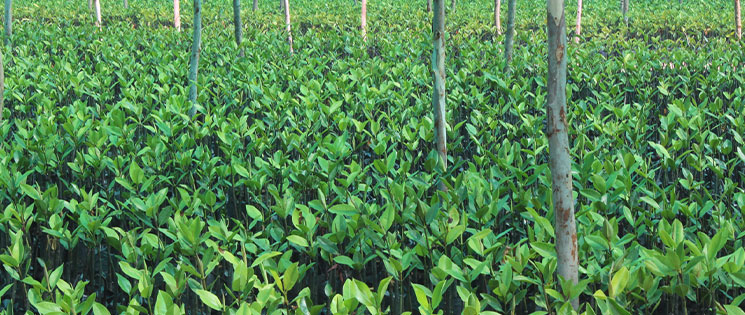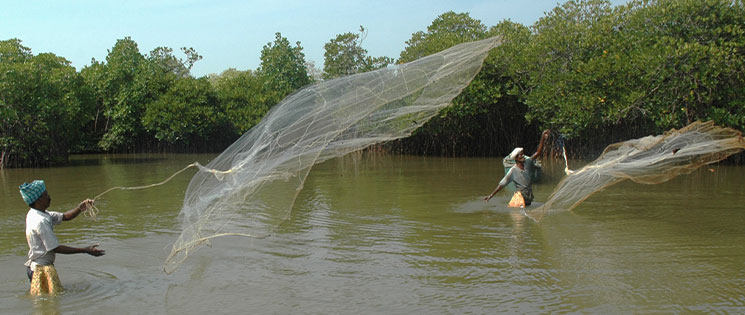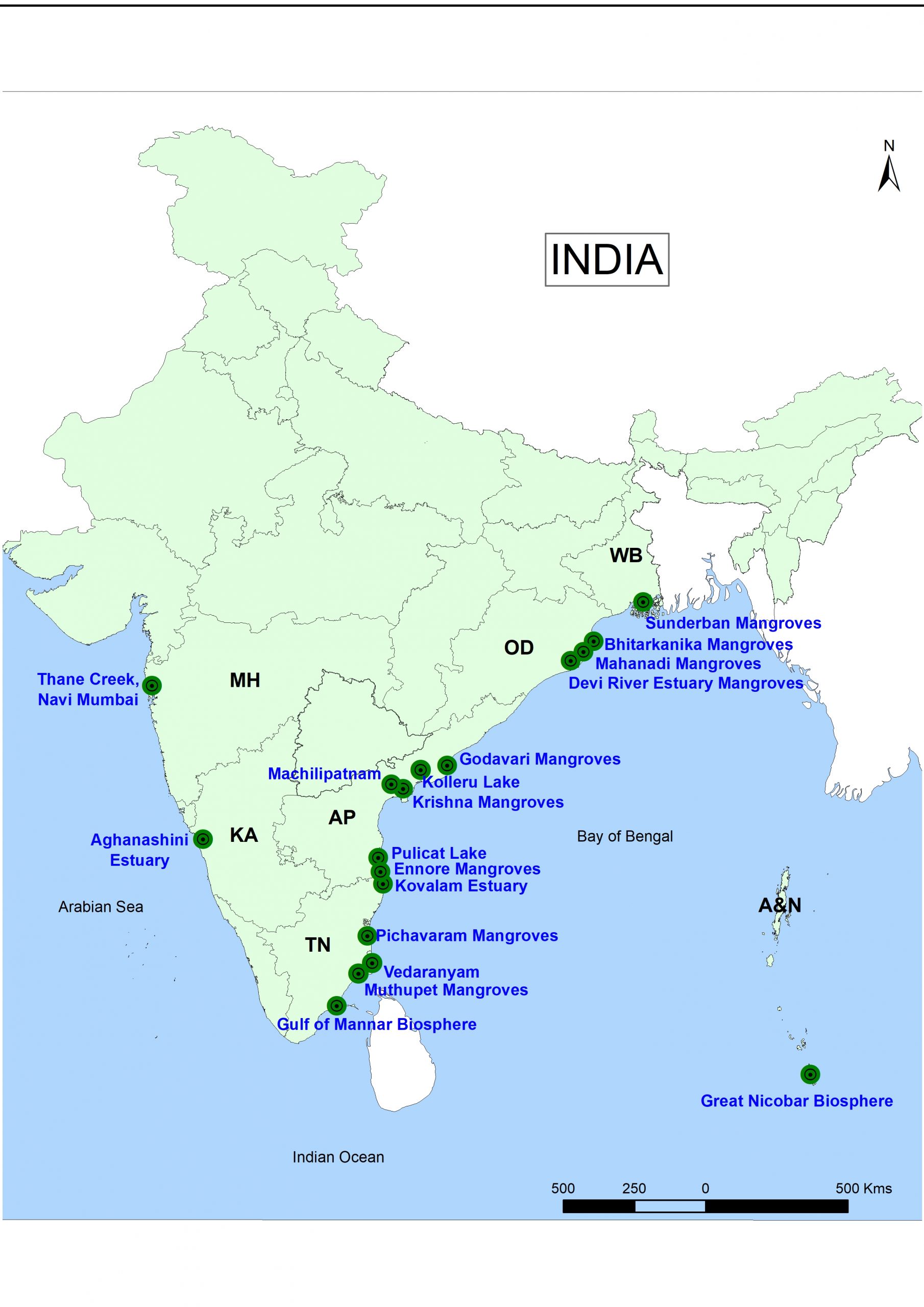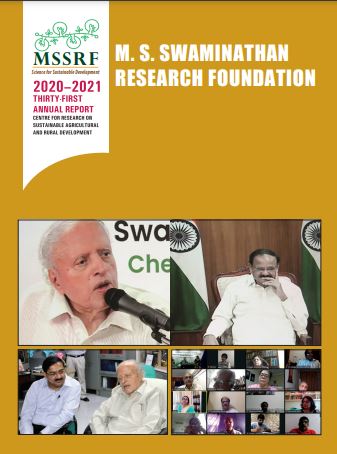Need for a Coastal Systems Research (CSR) on the model of Farming System Research (FSR)
According to UNESCO, 6 out of every 10 people in the world live within 60 km of the seashore.
India has a coastline of over 7500 km and Tamil Nadu’s coastline extends across 1000 km (Maps). Coastal communities depend for their livelihood largely on fisheries, forestry, animal husbandry and tourism. Because of population pressure and unsustainable development, coastal areas are getting bereft of natural biological wealth such as mangroves, sea grasses and coral reefs. Coastal ecosystems are characterized by high genetic diversity and can be regarded in terms of their biological richness as the marine equivalent of tropical rain forests. Yet, the contribution of oceans to the food resources of the world is less than 10 percent of the amount harvested from the land. Unfortunately, a detailed ocean capability classification analogous to land capability studies is yet to be undertaken. As much carbon is fixed in the oceans as on land. Further, the prospects for sea level rise as a result of global warming, and the consequent melting of glaciers, arctic and Antarctic ices and other ice caps, are real.
Most people inhabiting the coastal areas of India are poor. Women generally perform unskilled and underpaid jobs and child labour persists. The vast coastal region of India could provide a reasonable quality of life to large numbers of people provided economic development is based on the foundation of ecological security. MSSRF has hence developed a Coastal Systems Research (CSR) on the model of Farming System Research (FSR) as the first area of concern of the organization. The CSR was developed based on some well defined criteria and principles.
Criteria for Coastal System Research
- Research on coastal ecosystems has so far mostly been on specific components of the system and not on the system as a whole. Thus, marine biologists and fisheries scientists have studied different aspects of the ocean surface from the point of view of yield of aquatic products. Botanists, foresters and agricultural scientists have studied several aspects of coastal vegetation and farming practices. Integrated studies of sea and land surfaces and of capture and culture fisheries and coastal forestry and agro-forestry by inter-disciplinary teams are yet to be undertaken on any significant scale.
- It should have a large extrapolation domain from the point of the significance of the results for people and places.
- It should offer opportunities for participatory research and knowledge management with local communities.
- The project should offer scope for addressing issues relating to ecological and livelihood security in an interrelated manner.
- It should lend itself for study by a small group of trained scientists and should be capable of attracting financial support over a period of time.
- The Tsunami of December 26, 2004 underlined the urgency of introducing in coastal areas an integrated development-cum-disaster management programme comprising Bio-shields, Bio-villages and Village Knowledge Centres. Sea water farming and development and cultivation of salt tolerant crops will also have to be promoted.
Principles that followed the steps for Coastal System Research
- The research programme must be participatory in nature, involving the active participation of coastal families in all phases of both planning and implementation.
- The area taken up for integrated studies can be about 10 km .of sea surface and 10 km .of land surface in terms of width. The length can be adjusted to suit an administrative unit such as Community Development Block (for Panchayath Union as termed in Tamil Nadu).
- The first step is to understand the current pattern of human resources development, natural resources management and economic development in the area. The human impact on the coastal ecosystem will have to be studied from both the positive and negative angles.
- Based on the nature of anthropogenic pressures and pattern of economic development, a set of indicators to measure sustainability and unsustainability in the use of environmental capital stocks will have to standardised.
- The sources of livelihood on the existing patterns of resource use and technology adoption will be assessed. The linkages between the current patterns of employment and income generation with the ecological security of the coastal area will be studied for methods of calculating Livelihood Security Index
- The opportunities available for improving employment and income through the introduction of new technologies, and through improved training and trade will be studied. Opportunities for blending the new technologies with traditional wisdom and do-how will be explored. The available options will be presented to the rural families.
- Based on the decisions of the local farm and fisher families, a programme of demonstrations, training and development will be initiated
A monitoring system operated by local youth will be developed for ensuring that a higher rate of growth in economic well-being is not accompanied by long-term damage to the environment
A CSR methodology has been developed in line with the Farming Systems Research (FSR) methodology, which already widely used by agricultural scientists world-wide. Following core programmes are in operation in the light of the criteria and principles explained.
CSR Methodology
The steps involved in CSR are given in the box, based on the principles that follow.
Step I: Survey/and analysis of current patterns of economic development and natural resources management and the development of a Resource Management Balance Sheet.
Step II: Analysis of the’ linkages between the livelihood security of local communities and the ecological security of the coastal zone.
Step III: Based on a clear understanding of sustainability and unsustainability indicators, develop a plan for the integration of appropriate new technologies with current technologies in such a manner that both the economic well-being of the coastal community and the ecological foundations of coastal aquaculture and agriculture can be concurrently strengthened. Finalise the plan in consultation with the local community.
Step IV: Articulate clearly the technological intervention points in the areas of capture and culture fisheries, coastal forestry and agro-forestry and coastal crop and animal husbandry. Identify the new material and management procedures required and the changes needed in the marketing procedure for making it producer-oriented. Discuss these with the local community.
Step V: Based on the views of the local famil1es, introduce technologies which can help to elevate and stabilise the productivity and profitability of coastal fanning systems and support such introduction with appropriate training/re-training programmes and with the basic essential infrastructure for storage, processing and marketing.
Step VI: Help to mobilise the needed credit, insurance, marketing and public policy support needed for the successful refinement and dissemination of ecologically sound methods of natural resources utilisation.
Step VII: Organise the necessary demonstration, on-farm research, fish seed and feed production and all other steps needed for the Sustainable Coastal Ecosystem Management (SCEM) package for widespread adoption and impact. The SCEM package should spell out for each area the precise technologies, services and public policies needed for the package to find favour among the concerned people and thereby trigger a self-replicating pattern of coastal eco-development.
Step VIII: Develop and introduce suitable monitoring tools and promote organisational structures for group endeavour in areas like prevention of sea erosion and conservation of coastal vegetation as well as in processing and marketing.
Resource Centre for Integrated Coastal Zone Management
This Resource Centre is designed to assist Government, Civil society organizations and Panchayati Raj institutions in building their capacity for conserving and rehabilitating degraded mangrove ecosystems, development of non-mangrove bio-shields comprising plantations of casuarinas, cashew nut and appropriate halophytes, agronomic rehabilitation of farm fields subjected to sea-water inundation and the management of disasters.
The activities of the Centre now spread across coasts of Tamil Nadu, Andhra Pradesh, Karnataka and Maharashtra. The major activities include, assisting local communities and Forest and Fisheries Department Officials to work together in Joint Mangrove Forest Management, and agriculture department officials to engage in joint programme for coastal agriculture. In addition, it is hosting in collaboration with the JRD Tata Ecotechnology Centre and the Jamsetji Tata National Virtual Academy, a “Fish for All” Training Centre as well as a Village Resource Centre which provide up-to-date information on wave heights, location of fish shoals and potential disasters like cyclones, sea water ingress and tsunami. The Fish for All Training Centre is functioning like a Krishi Vigyan Kendra in terms of pedagogic methodology (i.e., learning by doing) and will provide training in many aspects of fish capture, culture, consumption and commerce.
Mangrove Wetlands Research
CSR is designed to provide the scientific basis needed for fostering a community-centred and process-oriented approach to conserve, restore, and sustain mangrove wetlands. All Mangrove wetlands, irrespective of ownership, received scientific attention. Community restoration techniques, such as raising community nurseries have been given particular emphasis. Systems of raising agro-aqua farms through integrated production of prawns and fish and the raising of mangrove plantations have been developed. Monitoring of the status of mangrove wetlands through remote sensing is a continuous process.
Generating opportunities for sustainable livelihoods
Population pressure is increasing in coastal areas. Hotels and Resorts to promote tourism are also growing in numbers. Ultimately, the fate of coastal ecology will depend upon the opportunities created for sustainable livelihoods to the fisher, farm and non-farm communities living within 10 kms from the shoreline. A project (2011-2017) with support of the Ministry of Environment and Forests- Society of Integrated Coastal Management under World Bank umbrella called “Conservation and Development of the Vedaranyam Coast zone based on the Gandhian principles resulted in emergence of coastal Bio-villages. This project being operated in 49 villages of Vedaranyam coast of Tamil Nadu through the five work packages:
- Community mobilization and organization
- Natural Resource Management
- Village and Community development,
- Development of Salt Sathyagraha Memorial site,
- Training and Capacity Building.
Coastal Bio-villages are being promoted on the basis of the experience gained in the Gulf of Mannar, Pondicherry, Pichavaram and Muthupet areas, as well as in Andhra Pradesh, Orissa and West Bengal. Using the Bio-village Tool-Kit already prepared, capacity building programmes are being organized for NGOs, Panchayat leaders and SHGs in addressing concurrently issues relating to natural resources conservation and enhancement, and the generation of new market driven enterprises. The Coastal Bio-villages are to trigger an economic stake in natural resources conservation and ecological security. Collaboration could be established with the eco-villages sponsored by the Ocean Centre of IIT, Chennai along coastal Tamil Nadu, and other similar initiatives.
Thus, the Integrated Coastal Zone Management Programme is giving specific scientific attention to the conservation and regeneration of Mangrove wetlands and to the strengthening of the work and income security of coastal communities through market-driven eco-enterprises including eco-tourism. Initiatives like the artificial coral reef to rejuvenate fisheries getting replicated, where appropriate. The great lesson learnt is sustainable livelihood forms the foundation for sustainable development.
Research scholars will be afforded facilities for undertaking in-depth research on various aspects of coastal ecology, agronomy, aquaculture and other relevant areas which can help to improve the Integrated Coastal Zone Management methodology. Aquifer monitoring is also to be done, to warn local communities about impending ingress of sea water into the aquifer. So the case of promoting Low External Input Sustainable Agriculture and Aquaculture (LEISAA) through well designed training programmes.
Ongoing Projects
- Geographical Information System based Forewarning Model for Pest Management in Coastal Agriculture, Vedaranyam Block of Nagapattinam district, Tamil Nadu
- Conservation and Development of the Vedaranyam Coastal Zone based on the Gandhian Principles
- Studies on greenhouse gas fluxes in Pichavaram mangrove ecosystem, Southeast coast of India
- Restoration and management of mangroves along the Thane Creek in Navi Mumbai region
- Inventorisation and Monitoring of Biospheres Reserves in India using Remote Sensing and GIS Technology
- Mangrove restoration and afforestation in the degraded area





